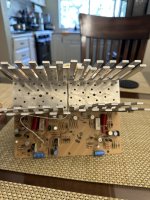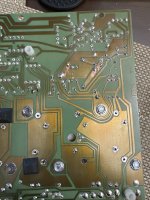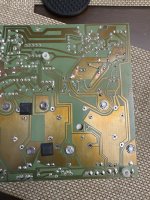I can tell you that I have 2 other units exactly the same and both are working without micas or silicon insulators. They all have grease and connected with screws to the heatsinks.
The only way you can do that is to use two separate heatsinks, one for each polarity of device,
and to mount the heatsinks on insulating spacers without the sinks touching each other.
and to mount the heatsinks on insulating spacers without the sinks touching each other.
Did I mention that I installed the suspected bad mosfets on the other channel and dc offset was perfect. I also played music thru it
Can anybody help me here with the testing strategy? I'm not sure what direction to go. The mosfets are currently not installed on the driver boards.
Correct. Do not worry.I can tell you that I have 2 other units exactly the same and both are working without micas or silicon insulators. They all have grease and connected with screws to the heatsinks.
This amplifier does not need insulators for the mosfet cases. The cases are all tied together and the heatsink is basically the output.
A passive observer, just reading this thread to learn something. Did crooner2264 ever answer daqvin_carter's question about the rubber feet? It seemed an easy thing to overlook and also a good idea to check.
I think most of the ones here with alot of repair experience are putting their betting money on a cold solder joint or metal bridge on a trace.
Yeah I looked under the rubber feet. Didn't see anything unusaulA passive observer, just reading this thread to learn something. Did crooner2264 ever answer daqvin_carter's question about the rubber feet? It seemed an easy thing to overlook and also a good idea to check.
Hi Nico Ras, cool user name. I am listening. What do you recommend?crooner is not listening, he is telling
Yeah maybe?I think most of the ones here with alot of repair experience are putting their betting money on a cold solder joint or metal bridge on a trace.
Sorry my bad this is the side. Things change when flip the board.Here's a pic of the board the right side is the problem child.
- Home
- Amplifiers
- Solid State
- can anyone offer help understanding the flow of this circuit


